Is your pool not looking its best? Dirty water, green spots, or odd smells can quickly turn your fun swimming spot into a big worry.
When pool care gets skipped or rushed, small problems can add up fast. Leaves and dirt settle, equipment gets blocked, and before you know it, the water just doesn't look the same and swimming doesn't seem so inviting.
But looking after your fibreglass pool is much easier than you might think. With a simple weekly routine, you can keep your pool clean, blue, and safe to swim in, year-round.
Read on for easy tips and expert advice, straight from years of experience, so your pool is always ready for a splash.
Highlights
- Regular cleaning, like skimming and brushing, keeps your pool water clear and helps stop algae from growing in fibreglass pools.
- Weekly vacuuming prevents dirt build-up at the bottom and keeps your water looking bright and inviting.
- Keeping chemical levels balanced means your pool water stays safe for swimming and protects the pool and its equipment.
- Never drain your pool to fix green water - instead, use a chlorine shock treatment to clear up algae safely and protect your shell.
- Checking baskets, filters, and running the pump daily helps your equipment last longer and avoid expensive repairs.
- Check the water table and use a pool cover when not in use; keep a maintenance log and always get help with big repairs.
Clean the Pool
As cliché as it may sound, keeping your pool clean is the most important job for any pool owner. Clean water not only looks inviting, but it also helps protect everyone who uses the pool from germs and keeps your pool's shell looking its best.
With a regular cleaning routine, your pool water stays sparkling and the surfaces remain smooth. Taking care of cleaning tasks is much easier with fibreglass pools because their surfaces are smooth, so dirt and algae don't stick easily.

Skim the Surface
While it cleans your pool surface, you also enjoy the moment catching those bugs and other objects through skimming. And if you don't skim, all that debris will eventually sink and make your pool harder to clean, which could block your filtration system.
Every few days, take a long-handled net, called a skimming net, and move it slowly across the pool water surface. The net catches leaves, grass, seeds, insects, and even bits of rubbish that blow in from the garden.
Try to make skimming a regular part of your routine. If there are lots of trees around or if it's been windy, you might need to skim more often.
After using the skimming net, clean it by giving it a good rinse with the hose. This helps it last longer and makes it work better.
Brush the Walls and Waterline
Brushing your pool is a way to stop algae and grime from building up in your pool. Although your pool looks clean, tiny bits of dirt, sunscreen, and oils can stick to the walls, corners, steps, and most of all, the waterline.
Use a soft pool brush, made for fibreglass pools, so you don't scratch the surface. Brush the entire pool once a week, or more often if you spot any green or dark marks starting to show up.
If you see something stubborn that won't brush off, try a gentle pool cleaner that's safe for fibreglass. Never use rough pads or harsh chemicals as they can damage the pool shell and make it dull.
Once you have brushed every part, you can combine this part with vacuuming. Just wait about 10 to 15 minutes to allow the dirt to settle on the floor.
Vacuum the Pool Floor
This is non-negotiable. Even if you can't see it, dust, sand, and small plant bits fall to the bottom and settle there. If this build-up is left alone, especially after brushing your pool, it can cause stains and make the water look cloudy.
Use a pool vacuum at least once a week. If you have a lot of trees or pets nearby, you may need to vacuum more often so we can avoid the build-up we're talking about.
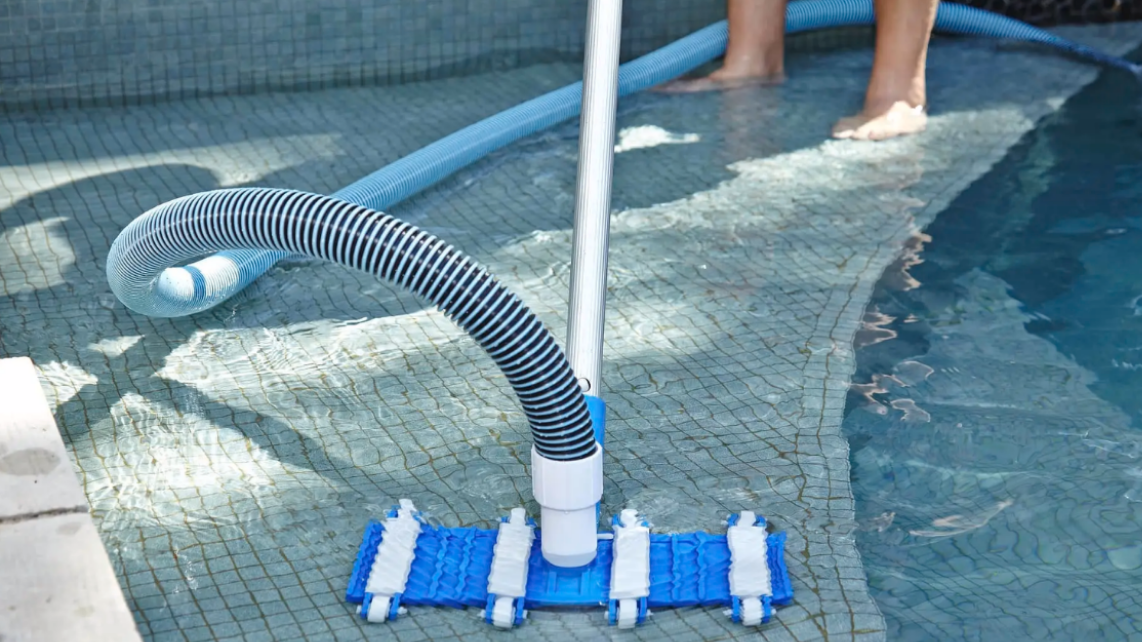
There are two types of pool vacuum: manual and automatic. With a manual vacuum, you move it slowly across the floor, overlapping each section so you don't miss any spots. If you have an automatic vacuum, just set it up and let it do the work.
If you're using a manual pool vacuum, follow these steps:
- Turn on your pool pump and filter and gather your vacuum tools: vacuum head, telescopic pole, long vacuum hose, and a vacuum plate fit to your skimmer box.
- Attach the vacuum head to the pole and hose. Lower it into the pool and remove air from the hose by holding the free end against the pool's return jet until bubbles stop coming out at the vacuum head.
- Connect the hose to the skimmer box. If you have a vacuum plate, attach it to the hose, seal it with your hand to keep air out, and fit it over the skimmer basket. If not, take the basket out and put the hose directly into the hole at the bottom of the skimmer.
- Move the vacuum head slowly along the pool floor. Use long, steady strokes and overlap each line a little to make sure every bit is cleaned. Go slow to avoid stirring up dirt and let your filter do its work.
- When you're finished, remove the vacuum and check your pump and skimmer baskets. Empty them if they have collected rubbish.
If you notice that the pool water has dropped while vacuuming, top it up with the hose so the level sits halfway up the skimmer opening.
Keep Water Chemistry Balanced
Clean water is just the start. To keep your pool safe and healthy, you need to balance the water chemicals as well. If the water is out of balance, it can turn cloudy, feel harsh on your skin, and even damage your pool's shell or equipment over time.

Adjust Chemical Levels
For this part, you'll need a liquid test kit or test strips you can get from any pool shop. Test at least once a week or more often after heavy rain, a pool party, or if the weather is really hot.
If you'll use the liquid test kit, always collect your water sample away from the skimmer or return jets, dipping a clean cup elbow-deep and turning it upright to fill.
There are five key things to check:
- pH Level: This should sit between 7.2 and 7.6. If pH is too low, water can be acidic, which is bad for swimmers and the fibreglass shell. if too high, the water goes cloudy and the chlorine does not work well.
- Chlorine: This needs to stay between 1.0 and 3.0 parts per million (ppm). Chlorine keeps the water clean by killing germs and algae. For most home pools, 1.5 ppm is a good target.
- Total Alkalinity: This keeps the pH steady. Aim for 80–120ppm. If it drops too low, the pH can swing up and down. If it's too high, the water might go cloudy and leave chalky marks.
- Calcium Hardness: For fibreglass pools, the ideal range is 175–275ppm. Too little can cause the gelcoat to lose shine; too much can make the water cloudy and coat surfaces with white scale.
- Cyanuric Acid (Stabiliser): For outdoor pools, keep it at 30–50 ppm to protect chlorine from sunlight. Too little means sunlight will break down chlorine too quickly, while too much can reduce chlorine's power.
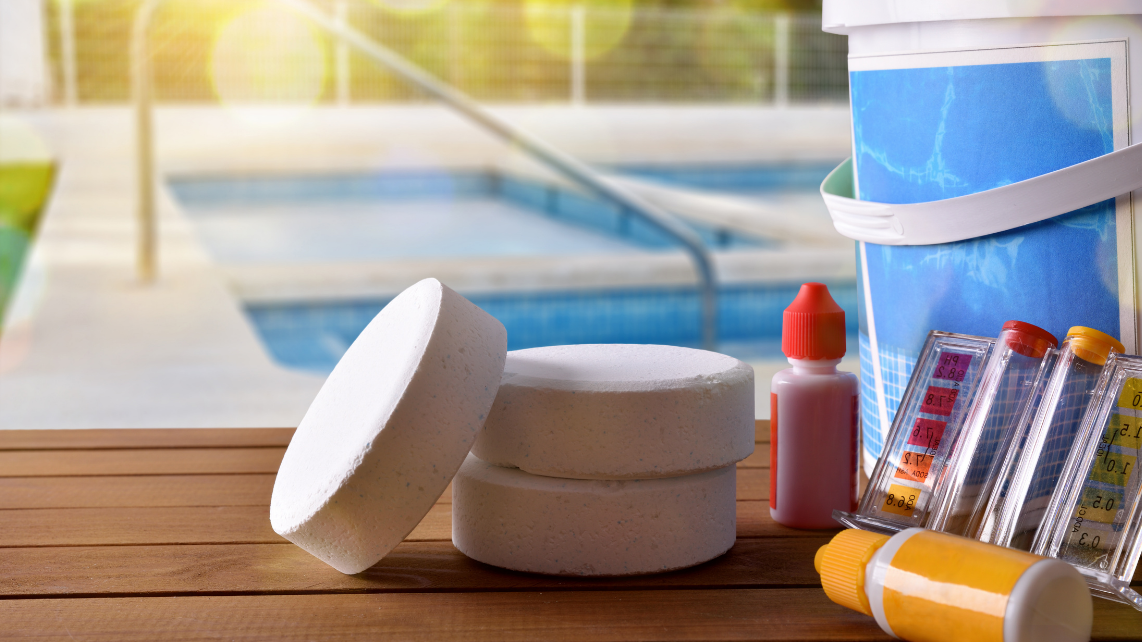
If any levels are off, add the right chemical one at a time. Wait at least 15 minutes after each. Add them with the pump running, sprinkle across the pool, and keep swimmers out for as long as the label says.
Now, add chemicals to fix anything out of range, following this order:
- Alkalinity: Adjust this before anything else. Raise it with baking soda or a pool alkalinity increaser. Lower it using pH decreaser or muriatic acid. Fixing alkalinity helps make pH easier to control.
- Adjust pH: Raise with pH increaser or soda ash, and lower with pH decreaser or muriatic acid.
- Chlorine: Add tablets, granules, or liquid to keep free chlorine in the right range. For salt pools, make sure there's enough salt for your generator.
- Cyanuric Acid (Stabiliser): If you use liquid chlorine or have a salt pool, add stabiliser if levels are low. Don't worry if your pool's not in direct sun, or if you use dichlor or trichlor tablets (they already have it).
- Calcium Hardness: Top this up only if it's low. If it's too high, the only way to lower it is by removing and adding fresh water.
The kits that you can buy in pool shops also have instructions on how to use them, read the result, and balance the water chemistry. It might be slightly different from what we've mentioned, but we recommend you follow it first.
Shock Treatment
Sometimes, normal amounts of chlorine aren't enough, like when the water looks a bit green, smells odd, or turns cloudy after lots of swimming or a storm. It's very tempting to drain all the pool water to fix the problem. But this is not a good idea for most fibreglass pools.
When you empty a green, neglected pool, the weight of water holding the fibreglass shell down is gone. Without this weight, the pool can lift or shift if the ground around it is wet or if the water table is high.

Instead of draining, the best and safest way is to shock the pool. Shocking means giving the pool a big dose of chemicals to kill off all the algae and bacteria.
There are a few different types of shock treatments you can use:
- Chlorine Shock: This is the most common type for green pools. It uses a large amount of chlorine to quickly break down algae and sanitise the water. Use it when the pool is very green and you can't see the floor. For best results, add the shock at night so the sun doesn't burn off the chlorine too quickly.
- Non-Chlorine Shock: This type uses a different chemical (often potassium monopersulfate) and is good for oxidising the water, but is less effective on heavy algae outbreaks. It's useful for regular pool care or after lots of swimming, but not when your pool is really green.
For a very green pool, always use a strong chlorine-based shock. After adding it, brush the walls and floor well, and keep the filter running day and night until the water starts to clear. It may take almost a day or more, and sometimes a second treatment if the water was extra murky.
Look After Pool Equipment
Taking care of your pool equipment keeps your water clean and helps your pool last for years. The right routine protects your investment and makes swimming safer and more fun for everyone.
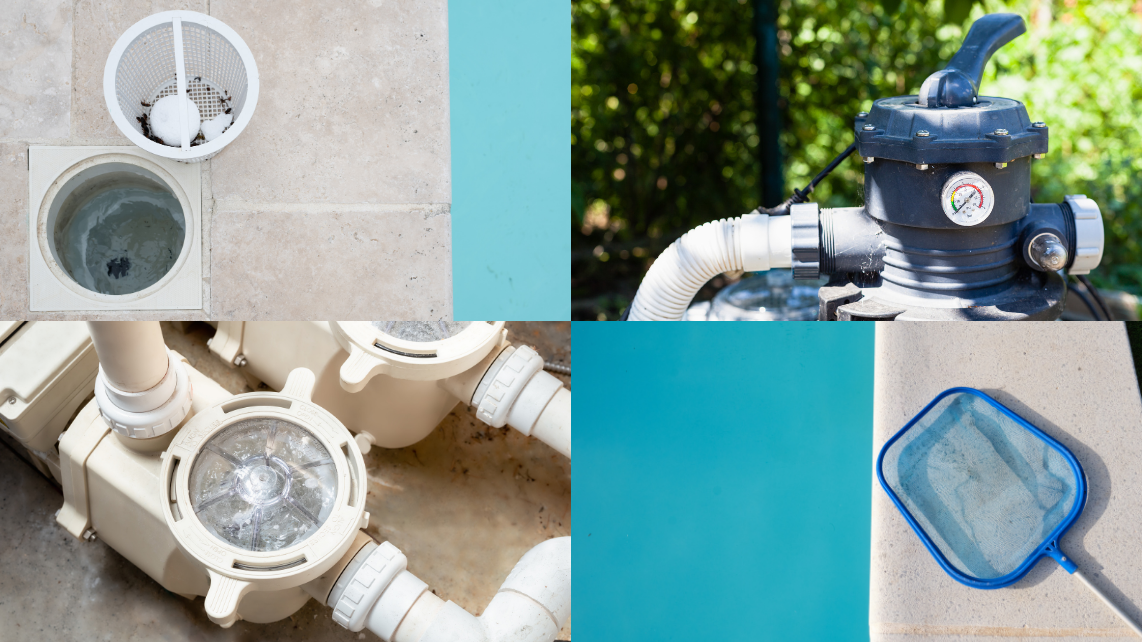
Clean the Skimmer and Pump Baskets
The skimmer and pump baskets catch leaves, insects, and rubbish before they get to your pump or filter. Always check these baskets every few days, especially after windy weather or storms.
Turn off the pump before you touch any part of the equipment. Pull out each basket, tip out the rubbish, and rinse with the hose. If you let these baskets get too full, the water can't flow well, making your pump and filter work much harder.
Sometimes you'll hear the pump start to make a strange noise or lose suction if the basket is clogged. Cleaning them regularly stops the pump from being damaged and helps your filter last much longer.
Clean or Backwash the Filter
Your filter's job is to catch dust, dirt, and fine particles that the baskets can't grab. The two most common types are sand filters and cartridge filters.
If you've got a sand filter, check the pressure gauge on the top. If the pressure is higher than normal (usually about 8–10 pounds higher than when clean), it's time to backwash.
After backwashing, always return the setting to 'rinse' for a minute before going back to 'filter'. Remember to check the pool water level and top up if needed, as backwashing can remove a lot of water.
If you have a cartridge filter, turn off the pump, open the filter lid, and take the cartridge out. Use a hose with a spray nozzle to remove all the dirt and grime. If the cartridge still looks stained or clogged after cleaning, or if water pressure stays low, it might be time for a new one.
Run the Pump
The pump is like the heart of your pool. It keeps water moving, so it goes through the filter and gets cleaned. It should run long enough to circulate all the water at least once every day. This is usually about 6 to 8 hours a day, but it could be more in hot weather or if the pool is used a lot.
Make sure the pump sounds normal when running. Any rattling or grinding is a warning. Stop and check the baskets or call a professional if you can't see the problem.
If you go away on holiday, set your pump to run every day. Still water quickly turns dirty and can grow algae, especially in warm weather. A well-run pump and filter keep your pool water clear, stop algae, and help all your chemicals do their job.
Check the Water Table
The water table is the amount of groundwater in the soil around your pool. Sometimes it may be too high, which can push up against the fibreglass pool and cause damage or pop it out of the ground. Checking the water table helps you catch problems before they start, especially after lots of rain.
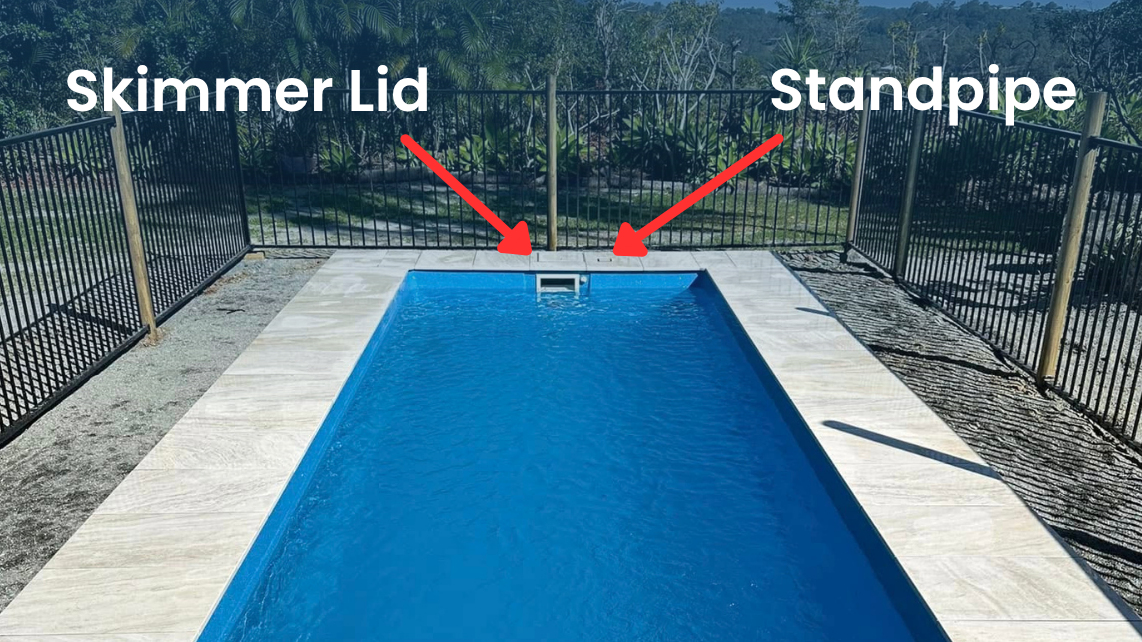
You should check the water table using the standpipe, or the vertical pipe beside or beneath the pool. Just take off the cap and use a stick to see where water is sitting. If the water level in the standpipe creeps up close to the bottom of your pool, you may need to lower it.
This is usually done by dropping a submersible pump down the standpipe and pumping water away slowly. Only remove a bit at a time, as moving water too quickly can risk more trouble.
The need for a standpipe and checks like these is set by the Australian Standards for fibreglass pool installation, and all professional installers should follow them. If you're ever worried about a rising water table, always get advice from a pool specialist, just to be safe.
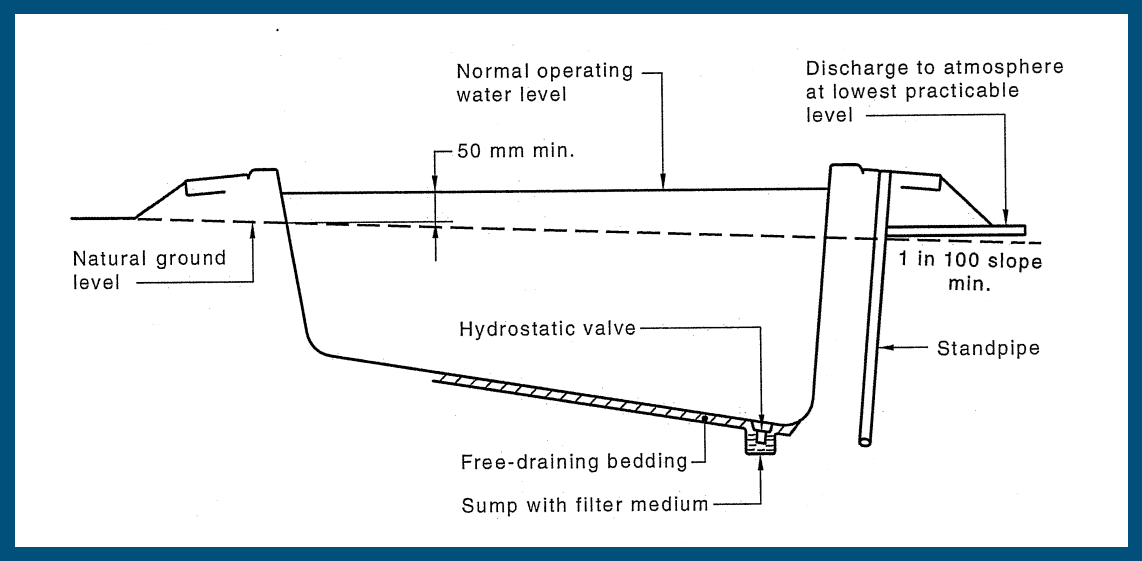 A figure from Page 10 of AS 1839:2021 showing pool drainage, hydrostatic valve, and standpipe.
A figure from Page 10 of AS 1839:2021 showing pool drainage, hydrostatic valve, and standpipe.
Maintain the Pool When Not in Use
When you're not using your pool for a while - maybe it's winter, or you're off on holidays - it's important to look after it properly. This extra care keeps your water clear, protects your fibreglass shell, and makes reopening much easier.
Cover the Pool
A pool cover is very useful when the pool's not in use. It keeps out leaves, grass, bugs, and all sorts of rubbish that would otherwise end up floating or sinking in your water. Blocking out sunlight also helps prevent algae from growing, so your pool stays fresher for longer.
Make sure your cover fits snugly with no big gaps, and fasten any straps securely. After rain, use a broom or soft scoop to clear off puddles so the cover doesn't sag or tear.
Even when covered, check the pool every week or so, looking for problems like holes or things trying to get under the cover. A good cover makes reopening the pool quick and easy.
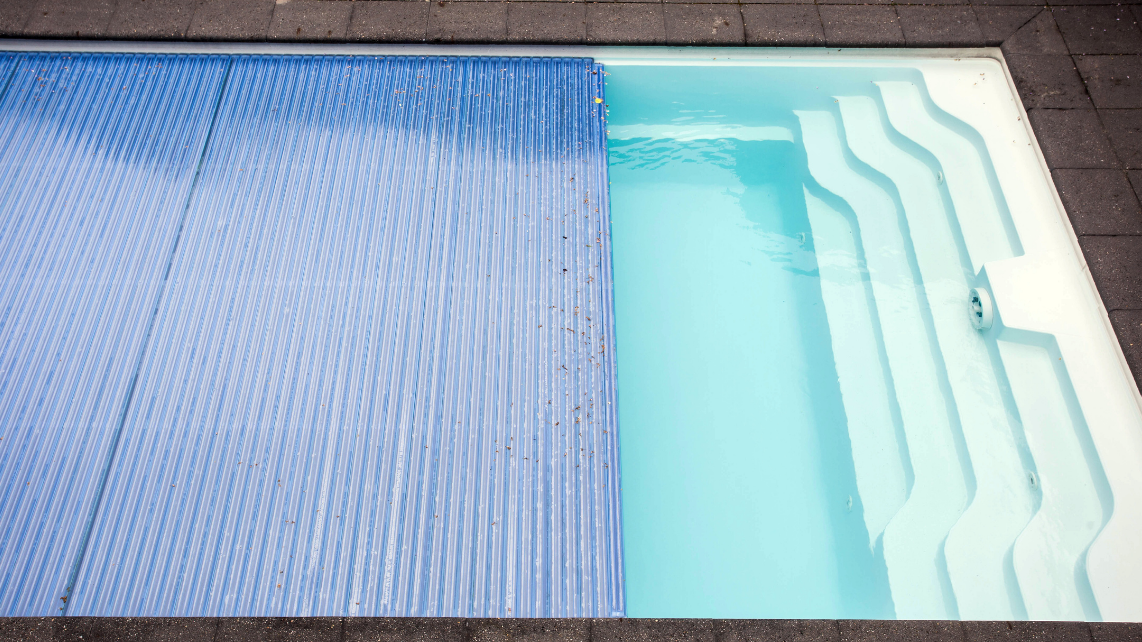
Balance Water Chemistry Before Closing
Before you 'close' your pool for winter or any long period, test and balance the water. Check the pH, chlorine, total alkalinity, and calcium hardness with a pool test kit. We've already mentioned earlier how to do that and what you need to look at.
If anything is out of range, adjust it before the break. For longer breaks, add a winter algaecide or slow-release chlorine tablet, but just make sure it's safe for fibreglass pools. Always follow the label instructions for any chemical you add.
Lower Water Level if Needed
In some areas, especially if you get lots of rain, you may need to lower the water level a bit before closing the pool. This stops water from spilling over and diluting your pool chemicals during storms or heavy downpours. The ideal spot is just below the bottom of the skimmer opening.
Once again, never empty your fibreglass pool completely.
If you need to lower the water, use a submersible pump or the pool's drain setting, but only after you've checked the water table using the standpipe. If the ground outside is too wet or saturated, hold off and call a pool professional for advice.
Keep Records and Get Professional Help
Sometimes you tend to forget everything you do for your pool, so keep a record or note. It will also be helpful if you ever need to make a warranty claim.
Start by writing down all your pool jobs in a notebook or use a simple app. Jot down the dates when you test the water, clean the baskets, backwash the filter, or add chemicals. If you fix something or notice a problem, write that down too.
Maybe you're busy and you don't have time to do all these steps or tips. That's when pool professionals do the maintenance job.
If your pool water keeps turning green, the pump sounds odd, a crack appears, or you find a leak you can't fix, it's best to get help. Pool professionals have the right tools and training to check your pool and fix things the proper way.
Never try big repairs, draining, or deep cleaning on your own if you're doubtful. You can search for solutions on Google or YouTube, but if you're really uncertain, you know who to call.
Final Thoughts
A well-cared-for fibreglass pool will always be ready for family fun and safe swimming. Sticking to a simple cleaning and maintenance plan helps prevent problems before they start. Little jobs done each week keep your water clear and your pool strong for years.
Remember to write down what you do and check your pool regularly. Small fixes now can save a lot of hassle and money later on, especially with the weather and ground conditions we get in Australia.
If you ever need help with your fibreglass pool maintenance or project, just reach out to us. We are licensed installers with years of experience installing and cleaning fibreglass pools in Mackay, and we're happy to chat or give you a quote.
And if you're still thinking about which fibreglass pool to choose, check out the fibreglass pool designs our partner offers. There's always something for every backyard and budget.
